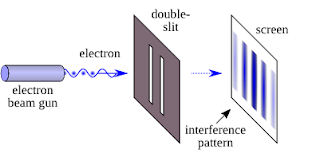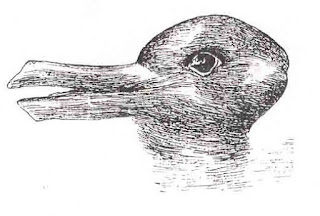 |
| Is the coin heads, or tails? |
 |
| The taijitu |
Let's try an easy
metaphor, first. Consider a coin; if you have one on your person,
take it out and have a look. There is a different picture on each
side, usually called “heads” and “tails”, or more technically
the “obverse” and “reverse”. You flip a coin, and it lands
with one or the other upwards. Try as you might, you can't see both
sides clearly at the same time. Yet a coin that has landed “heads”
still has the “tails” side, and vice versa. The coin is only
“heads” or “tails” based on its position in relation to other
objects – including the observer. This is even the root of a common
idiom in English – they are “two sides of the same coin”.
Different faces, or facets, or a indivisible whole.
For a deeper, if
more difficult to grasp analogy, I return to physics. Recall that I
mentioned, at the start of this post, that in physics, stemming from
mathematics, duality takes on a meaning that has some parallels with
the case of the coin, or with the dualism/non-dualism of the
Sandōkai. Two systems
or descriptions that describe the same phenomenon. The example in
physics that will be familiar, after a fashion, to most people is the
idea of wave–particle duality.
Certain objects in physics – or, you might say, in the physical
world – have both wave and particle properties. The way this is
often explained in schools is that they “sometimes behave as waves,
and sometimes behave as particles”, when in fact they actually
behave as both, all the time. They are both waves, and particles, or
alternatively you might say that they are neither. Yet both the wave
description and the particle description are vital in understanding
their behaviour in different circumstances.
 |
| The classic double-slit experiment |
From this
mathematical use, I will continue to use the term “dualism” for
its usual meanings – a division into two classes (i.e. a
dichotomy), or a system of oppositional forces or entities, and so
on. I will use “duality” for the sense seen in physics, where a
system can be described in two ways, but it is still one system. The
descriptions are more useful or relevant in different situations (or
perhaps to different people, which is an element of the situation),
but both of them remain descriptions of the same system – even if
they seem to be contradictory. This is the duality of Zen non-duality
as seen in the Sandōkai,
the tension of things being separate-yet-not-separate.
So it is, I have
come to see, with the Divine. Not that the Divine is both a wave and
a particle, but that it partakes of many natures at once, with none
of those natures fully describing it. Yet to apprehend it as best we
can, we must hold those conceptions, those ideas and natures, in
tension, and not close our minds to any of them.
Quakers who like
to consider theology have held one position in line with this for
some time – that they see God as both immanent and transcendent.
Across the huge range of conceptions found among liberal Quakers,
there are many apparent dichotomies represented; theist/non-theist is
actually just a handy way of lumping several together, and not all
who might be considered theists hold to all of the characteristics of
theism – while not all who call themselves non-theist, nor those
who might be analytically considered such, reject all of the
characteristics of theism. So we have many dichotomies even within
that classification scheme, where the Divine might be considered
personal (having personality, desires, opinions etc.) or not,
omnipotent or not, willing and able to act in the world directly or
not. Cutting across that scheme, we have dichotomies (or things split
into more than two classes) that occur in both camps, such as being
the ultimate creator or not, while within either “camp” we can
find dichotomies that apply largely with the group. These include,
for instance, the idea of substitutionary atonement, or more
fundamentally the nature and divinity of Christ; similarly, the
degree of materialism of non-theists – some being highly
supernaturalist but not identifying the supernatural force with any
theistic characteristics, and others being strictly materialist (in
the philosophical sense), rejecting supernaturalism.
All of these
classifications, even where they naturally present multiple classes
or exist on a continuum, can be arbitrarily defined in terms of
dichotomies – not something I recommend doing in most cases, as it
simplifies complexity when we should want to understand
complexity. In the sense of the argument I am making here, however,
it is important because the point I am making is equally valid
wherever you draw the line to create the dichotomy. Of course, there
is the definite dichotomy as to whether you consider the Divine,
whatever you call it, to have some objective reality – as a
personal, omnipotent God, or as an impersonal divine force or divine
essence within each of us – or to be entirely a construct of the
human mind. Lastly there is the question of whether you subscribe to
Cartesian dualism, the separation of mind (perhaps soul) and body, or
a materialistic monism (note that this is not the same thing as the
supernaturalist/“strict materialist” distinction, as
supernaturalism does not require non-materialist understandings of
that supernatural element).
Thus we have a
huge collection of dualistic descriptions. We tend to think of them
as dualistic, because logically Cartesian dualism excludes the
corresponding monism, supernaturalism excludes strict materialism,
the Divine as having independent, real existence versus being a human
construct, Christ as divine and the son of God excludes Christ as
just a man, or Christ as dubiously historical. I feel a growing
conviction that proper apprehension of the Divine will require us to
somehow see these as dualities instead. Those who are most logical
and analytical, as I tend to be myself, will struggle with this. How
can something be red and blue? How can it be straight and curved?
Simultaneous immanence and transcendence is also a contradiction,
long embraced in Christian theology by the multiple nature of God –
while the Father is transcendent, the Spirit and/or the Son are
immanent, with this being a fundamental purpose and result of the
incarnation; the Church of Latter Day Saints (Mormons),
self-identified as Christians though that identification is contested
by much of the Christian community, holds that all of creation is
filled with a divine immanence that they term the Light of Christ (a
term also used by Quakers with not entirely incompatible meaning).
Self and not-self is an obvious logical dichotomy, but several
traditions of Buddhism hold, as mentioned earlier, that enlightenment
involves seeing past that dichotomy to the unity of self and
not-self.
One could
approach it in the sense of the unity of opposites; that no member of
a dichotomy has meaning without its complement. Without darkness,
light has no meaning. Without the possibility of being hot, coldness
is unthinkable. This extends to cognitive dissonance, or even
antinomy, in the thinking of Kant. We are considering things which
extend beyond not just our actual experience, but our possible
experience. I agree with Kant that, in this situation, the
characteristics of reason that we learn from the world-as-experienced
cannot be maintained. As we explore these concepts and ideas, that
describe things that go beyond the tangible, we will find
contradictions. That is no reason to suppose we have taken a wrong
turning. Contradiction is, arguably, to be expected in this scenario.
(One quick aside
for those who hold to the relatively extreme non-theism espoused by
David Boulton. It may seem fundamentally even more impossible to
consider the Divine to have multiple, seemingly contradictory
characteristics when you consider that it does not exist outside of
human thought. However, existing only within human thought is a kind
of existence in itself – and that thing that exists in human
thought is thought to exist independently, as well as only within
human thought. That is your duality; as shall shortly become clear, I
hope, there is nothing wrong with only holding as much of the duality
as you can find capability for, but it should be approached
ambitiously.)
 |
| Is it a duck, or a rabbit? |
Perhaps this is
impossible for a person to do, to truly comprehend and accept. I
certainly can't claim that I do, even if I feel this clear leading
towards it. Perhaps it is possible, but only through an enlightenment
process that would move us beyond the human. But as Quakers, as a
Religious Society of Friends, we do not have to rely each of us upon
ourselves. My own understanding of the Light is that, when we worship
together, the Divine that exists in each of us, independently,
becomes connected and we have a gestalt divinity, a shared Light,
that exceeds the sum of the individuals'; I know that others, with
quite different conceptions of the Divine (including fairly
traditional Christian understandings), have ways of seeing collective
worship that are not terribly far from that. Perhaps, then, it will
do that we seek to allow that gestalt to see these dualities, this
unity of contradictions.
As a worshipping
community, as a Religious Society, we can collectively hold this
contradiction; seeking to hold it as individuals would certainly be
good, but we will run up against limitations. Our collective
spirituality, however, need not be concerned with these limitations.
The leap of understanding that we need as individuals is simply to
understand the idea that contradiction need not mean exclusion, that
our collective cooperation and seeking for Truth need not require
agreement. The concept of duality of apparently contradictory ideas,
the idea of Kantian antinomy as no intellectual flaw, might be a way
to help us do this.
~ ~ ~ ~ ~
Did you enjoy this post, or find it interesting, informative or stimulating? Do you want to keep seeing more of these posts? Please consider contributing to my Patreon. More information is available in the post announcing my use of Patreon.
Did you enjoy this post, or find it interesting, informative or stimulating? Do you want to keep seeing more of these posts? Please consider contributing to my Patreon. More information is available in the post announcing my use of Patreon.